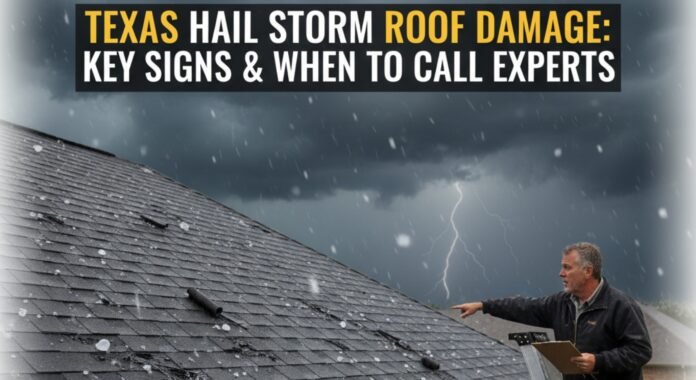Summary:
This comprehensive guide covers identifying hail damage on Texas roofs, from visible shingle damage to subtle structural issues. It explains when homeowners can safely inspect damage themselves versus when professional assessment is critical, typical repair costs, insurance considerations, and preventive measures. Key takeaways include conducting immediate post-storm safety checks, documenting damage for insurance claims, and understanding that some damage may not be immediately visible but can lead to costly repairs if left untreated.
Texas is notorious for severe hailstorms that can cause devastating damage to residential and commercial roofing systems. With hailstones ranging from pea-sized to softball-sized, knowing how to identify damage and when to seek professional help can save homeowners thousands of dollars in repairs and prevent long-term structural issues.
Understanding Hail Damage Patterns in Texas
Texas experiences some of the most intense hailstorms in the United States, particularly during spring and early summer months. The state’s unique geography creates perfect conditions for supercell thunderstorms that produce large, destructive hail. Areas like the Dallas-Fort Worth metroplex, Austin, San Antonio, and Houston corridors are especially vulnerable to severe hail events.
Hail damage occurs when ice pellets impact roofing materials at high velocity, often exceeding 100 mph during severe storms. The size, density, and wind speed of hailstones directly correlate with the extent of damage inflicted on roofing systems.
Immediate Signs of Hail Damage to Look For
Exterior Roof Damage
The most obvious indicators of hail damage appear on the roof’s exterior surface. Look for circular dents or bruises on asphalt shingles, which may expose the underlying mat or create soft spots that feel spongy when pressed. Metal roofing systems often show denting, scratching, or chipped protective coatings.
Granule loss is another critical sign, particularly on asphalt shingles. Check gutters and downspouts for excessive granule accumulation, which appears as coarse, sand-like material. Fresh granule loss will expose darker underlying asphalt, creating a speckled appearance across the roof surface.
Structural and Secondary Damage
Hail can crack or split shingles, tiles, or other roofing materials, creating entry points for water infiltration. Examine flashing around chimneys, vents, and skylights for dents or displacement. Gutters and downspouts may show denting, while siding and windows can exhibit impact marks or cracks.
Interior Warning Signs
Water stains on ceilings or walls often indicate compromised roofing integrity. Peeling paint, sagging drywall, or musty odors may suggest moisture infiltration following hail damage. These interior signs sometimes appear days or weeks after the initial storm event.
Safety Considerations for Self-Inspection
Homeowners can safely perform ground-level inspections using binoculars to examine roof surfaces from a distance. Check the property perimeter for fallen shingle pieces, damaged gutters, or other debris. However, never attempt to climb onto a potentially damaged roof, especially during or immediately after severe weather.
Use a ladder only if absolutely necessary and ensure proper safety protocols, including having someone spot you and inspecting the ladder for damage. Wet or damaged roofing surfaces present significant slip hazards that can result in serious injury.
When Professional Assessment Becomes Essential?
Complex Damage Evaluation
Professional roofers possess specialized training to identify subtle damage that untrained eyes might miss. Storm damage often affects multiple roofing system components simultaneously, requiring comprehensive evaluation beyond surface-level inspection.
Structural engineers may be necessary when hail damage affects load-bearing elements or when extensive damage compromises the roof’s overall integrity. Insurance adjusters also provide professional damage assessment for claim purposes.
Insurance and Documentation Requirements
Most insurance policies require professional documentation for hail damage claims. Roofing contractors experienced with insurance processes can provide detailed reports, photographs, and repair estimates that support claim submissions.
Professional assessments typically occur within days of the storm event, as insurance companies often impose strict reporting deadlines for weather-related damage claims.
Long-Term Consequences of Delayed Action
Untreated hail damage creates cascading problems that exponentially increase repair costs. Small granule loss or minor cracking can evolve into significant leaks, mold growth, and structural deterioration. Texas’s intense UV exposure and temperature fluctuations accelerate the deterioration of compromised roofing materials.
Water infiltration through damaged roofing can affect insulation, electrical systems, and interior finishes, transforming manageable roof repairs into extensive home restoration projects.
Preventive Measures and Maintenance
Regular roof maintenance and prompt storm damage assessment significantly reduce long-term repair costs. Schedule annual professional roof inspections, particularly before and after hail season. Maintain clean gutters and ensure proper attic ventilation to minimize secondary damage from moisture infiltration.
Consider upgrading to impact-resistant roofing materials if you live in frequently affected areas. Class 4 impact-resistant shingles can significantly reduce hail damage and may qualify for insurance discounts.
Protecting Your Texas Home from Hail Damage
Texas hailstorms pose serious threats to roofing systems, requiring immediate attention and professional evaluation when damage occurs. While homeowners can identify obvious damage signs, professional assessment ensures comprehensive damage evaluation and proper insurance documentation. Acting quickly after storm events prevents minor damage from becoming major structural problems, protecting both your home’s integrity and your financial investment.
Remember that hail damage isn’t always immediately visible, and consulting with the best roofing contractor in Webster, Texas is invaluable for protecting your property’s long-term value and safety.

